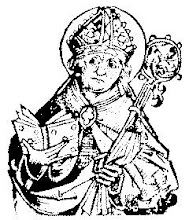Over the last few months it's been getting progressively more and more noisy in our church both before and after Mass. More and more people seem to treat coming to Mass like a social gathering - as a chance to chat to those friends you haven't seen for a week.
Inevitably, the same people don't "have the time" to join in actual parish social occasions. Most won't even stay after Mass for a cup of tea and a chat.
This has really been getting to me, so I was heartened to see respected commentator George Weigel posting about this same topic just recently. Here is what he had to say:
The Chattering Classes Are UsThe subtitle of his post is "The Catholic Difference". Perhaps it should be "The Catholic Indifference".
George Weigel
Posted: Wednesday, January 26, 2011
THE CATHOLIC DIFFERENCE
Publication Date: January 19, 2011
Catholics once had an intuitive understanding of sacred space: to enter a church, especially in the presence of the Blessed Sacrament, was to enter a different kind of environment, one of the hallmarks of which was a reverent silence. Some of that intuition remains. But much of it has been lost. Thus, within the past few months, I have noted three habitual behaviors, not in parishes that are otherwise sloppy in their liturgical practice, but precisely in parishes that take their liturgical life seriously:
1) The demarcation between the narthex (or, as they say in AmChurchSpeak, the "gathering space") and the body of the church (a.k.a. the "worship space") has been severely eroded. Conversations begun in the narthex often continue when people reach the pews; new conversations are initiated in the pews. Both types of conversation sometimes continue during the choral prelude, if there is one. In any case, the new convention seems to be that in-pew conversations are quite appropriate until the processional hymn is announced.
2) The exchange of peace, which ought to be accompanied by the briefest of greetings, often becomes the occasion for a general conversational free-for-all. This breaks the rhythm of the Liturgy of the Eucharist and is anything but conducive to the gathering of mind and spirit appropriate to the period before the reception of holy communion.
3) Immediately after the conclusion of the recessional hymn, conversation, often quite loud, immediately breaks out in the pews (among those, that is, who have not already bolted for the door during the recessional). Choirs who have spent time and effort preparing a choral postlude must therefore compete with a torrent of chatter that not infrequently drowns out music that has been carefully rehearsed. This chatter is both bad liturgical form and very bad manners. Attempts to remind one's fellow congregants of the proprieties, through a pleading glance, are met with either incomprehension or hostility.
2011 could be a year in which the liturgical catechesis enjoined by Vatican II as part of the reform of the liturgy actually takes place: if pastors and parish liturgy directors see the introduction of the new English translations that will become mandatory on the First Sunday of Advent as the occasion to do what should have been done forty years ago, and equip the saints -- who have too often devolved into the liturgical chattering classes -- for their part in worship. That part was beautifully defined by the fathers of Vatican II in the chapter on the Holy Eucharist of the Council's Constitution on the Sacred Liturgy:
The Church...earnestly desires that Christ's faithful, when present at this mystery of faith, should not be there as strangers...They should give thanks to God. Offering the immaculate victim, not only through the hands of the priest but also together with him, they should learn to offer themselves.
That offering of self takes place through silence as well as through the "full, conscious, and active participation" the Council enjoined -- a "participation," I might add, that was not envisioned as obliterating the distinction between behavior appropriate to the parish hall and behavior fitting for the body of the church. Both our participation in the liturgy and our silence should reflect the distinctiveness of the sacred space that we are privileged to share when we come into church. If there is little discernible difference in our parishes between what happens in the narthex before and after Mass and what happens in the body of the Church during Mass, something is wrong.
Pastors and liturgical directors have a great opportunity this year to re-educate Christ's people in the nature of the liturgy. That education can be both direct and indirect: direct, by catechesis from the pulpit; indirect, by providing ample moments of silence within the liturgy. There is no reason why every available moment during Mass must be filled with speech or music; surely there ought to be moments of repose when all are allowed to listen for the "still small voice" of 1 Kings 19.12. Those moments, in turn, might help remind us that sacred space is not space for chatter.
h/t: Fr James Farfaglia at Illegitimi non carborundum






